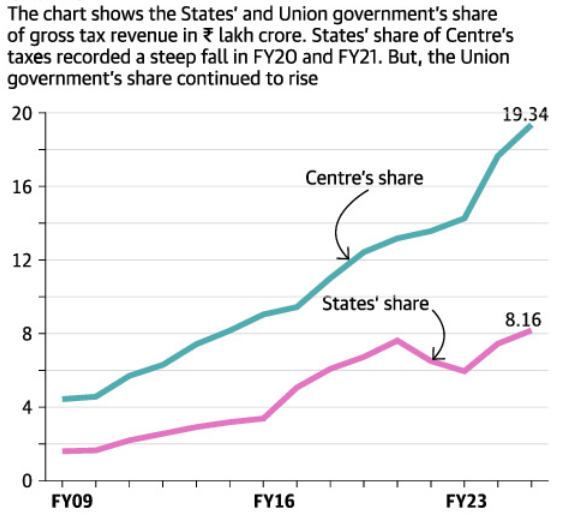ForumIAS announcing GS Foundation Program for UPSC CSE 2025-26 from 19 April. Click Here for more information.
ForumIAS Answer Writing Focus Group (AWFG) for Mains 2024 commencing from 24th June 2024. The Entrance Test for the program will be held on 28th April 2024 at 9 AM. To know more about the program visit: https://forumias.com/blog/awfg2024
Contents
- 1 What is the reason for the poor financial health of States’?
- 2 About the financial health of the Centre
- 3 About the Centre’s revenue sharing with states and the role of the Finance Commission
- 4 What is the reason for the persistence of imbalance?
- 5 What is the status of Cess and Surcharge according to the CAG report?
Source: The post is based on the article “A Centre-State skew further widened” published in The Hindu on 23rd August 2022.
Syllabus: GS 2: Issues and challenges pertaining to the federal structure.
Relevance: To understand the issues of the financial health of States and Centre.
News: In a NITI Aayog meeting chaired by the Prime Minister, various Chief Ministers expressed their concern about dwindling State revenues. They sought a higher share in the divisible pool of taxes and an extension of GST compensation.
What is the reason for the poor financial health of States’?
a) Slowdown in growth in 2019-20, b) Implementation of the Ujwal DISCOM Assurance Yojana, c) Providing farm loan waivers, d) Heightened health and other expenses during the pandemic, and e) Revenue shortfall: Due to the reduction in gross tax revenues of states during the pandemic and the States’ share of the Union government’s taxes recorded a steep fall of 15% and 9% in FY20 and FY21, respectively.
About the financial health of the Centre

The Union government’s share continued to rise while the state government face financial issues. This is because, a) Even though the Finance Commission raised the States’ share in Central taxes, it didn’t translate into an increase in the actual share devolved as the divisible pool shrank, b) The Centre increased its revenue by levying cesses and surcharges which are not shareable with the States. For instance, their contribution raised from 10.4% in FY12 to 20% by FY21. This has also shrunk the divisible pool of resources.
About the Centre’s revenue sharing with states and the role of the Finance Commission

The Constitution grants the Union government more revenue-raising powers while the States are tasked to undertake most of the development and welfare-related responsibilities.
According to the 15th Finance Commission’s report, in FY19, the Union government raised 62.7% of the total resources raised by the Union government and States, while States had borne 62.4% of the aggregate expenditure.
The role of FC to correct the imbalance: The allocation of taxation powers and expenditure responsibilities to centre results in an imbalance. the Constitution provides for sharing of the Union government’s revenue with the States. Successive Finance Commissions (FC) have attempted to reduce the imbalance by increasing the States’ share in Central taxes.
What is the reason for the persistence of imbalance?
Though the 14th and 15th FC raised the share of States in gross taxes to over 40%, the actual share never reached the mandated level. At present, the actual devolution has widened to more than 11 percentage points, the highest in at least two decades.
What is the status of Cess and Surcharge according to the CAG report?

Various cesses and charges are imposed by the government to raise resources. They are transferred to Reserve Funds to ensure that they are being used for the intended purpose. But according to the CAG report, this has not happened.
For instance, between FY10 and FY20, ₹1.28 lakh crore was collected as a cess on crude oil. However, not a single penny was transferred to the Oil Industry Development Board (OIDB).




